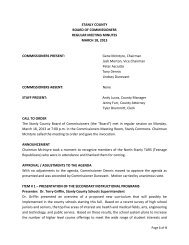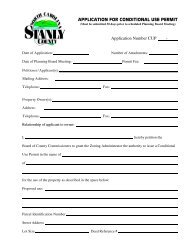Land Use Plan – 2002 - Stanly County, North Carolina
Land Use Plan – 2002 - Stanly County, North Carolina
Land Use Plan – 2002 - Stanly County, North Carolina
Create successful ePaper yourself
Turn your PDF publications into a flip-book with our unique Google optimized e-Paper software.
STANLY COUNTY<br />
Because of these factors, for farming to continue to be marginally profitable and free of<br />
nuisances in <strong>Stanly</strong> <strong>County</strong>, large areas of farmland need to be conserved to provide a critical<br />
mass that will reduce the number of farmer-suburbanite and farmer-driver conflicts. While the<br />
<strong>Land</strong> <strong>Use</strong> <strong>Plan</strong> will encourage the preservation of individual properties, emphasis will also be<br />
placed on protecting farmland on a holistic basis.<br />
In many places, farmland is viewed as open space awaiting development for more-intensive<br />
development such as housing, retail, or other more intensive development activity. This<br />
viewpoint belies a couple of important facts about farming in <strong>Stanly</strong> <strong>County</strong>. First, farming isn’t<br />
simply an occupation, but an employment and lifestyle that supports the framework of<br />
communities that exist in <strong>Stanly</strong> <strong>County</strong>. In relative terms farming is not a large employer in the<br />
<strong>Stanly</strong> <strong>County</strong> community. While only 2.1 percent of <strong>Stanly</strong> <strong>County</strong> workforce counted<br />
themselves as employed by the agricultural/forestry/fisheries industries in the U.S. Census in<br />
2000, in 1999 there were 55,000 acres of farmland in <strong>Stanly</strong> <strong>County</strong> that produced an estimated<br />
$61 million in cash receipts (<strong>North</strong> <strong>Carolina</strong> Department of Agriculture).<br />
Second, <strong>Stanly</strong> <strong>County</strong>, like most developing rural counties, is more than likely unprepared for<br />
the ramifications of build-out of all agricultural lands in the study area. According to the <strong>Land</strong><br />
<strong>Use</strong> <strong>Plan</strong> Phase 1 Report, approximately 63,542 acres of land is used for farming within the<br />
<strong>Land</strong> <strong>Use</strong> <strong>Plan</strong> study area, or approximately 36 percent of the study area. This land, along with<br />
an additional 89,048 acres of wooded land, were they to be fully developed under present<br />
zoning, would result in an additional 358,567 residents to the <strong>Stanly</strong> <strong>County</strong> population over the<br />
next century. Appendix B provides an explanation of the manner in which this figure was<br />
calculated.<br />
Before moving on, it is important to discuss the issue of prime farmland relative to the<br />
preservation of farmland areas in <strong>Stanly</strong> <strong>County</strong>. Section 3 of this report discusses extensively<br />
the issue of prime farmland in the county. Approximately 20 percent of the county’s land area<br />
(including municipalities outside of the study area) is defined as those soils that “…are best<br />
suited to producing food, feed, forage, fiber, and oilseed crops (USDA).”<br />
The land recommended for farmland protection is not necessarily limited to these areas just as<br />
farming in <strong>Stanly</strong> <strong>County</strong> is not limited to prime farmland. As a matter of fact, using the scientific<br />
definition of prime farmland would limit the ability of <strong>Land</strong> <strong>Use</strong> <strong>Plan</strong> to meet the first defining<br />
principle of the plan. A significant percentage of “prime farmland” is located in or near the<br />
corporation limits or ETJs of several cities and towns in the county particularly on the north side<br />
of Locust, Millingport, New London, and Richfield. While this land may be worthy of protection<br />
and preservation, retaining this land for farming could potentially accomplish two unacceptable<br />
outcomes. First, preserving this land would draw development away from these communities<br />
where it is most desirable. Urban services such as utilities, schools, and parks could become<br />
underutilized or underfunded because natural growth areas are preserved. Secondly, preserving<br />
this land would divert development to areas of the county where it is undesirable.<br />
3. Focus development to areas of the county where the physical conditions of the<br />
land can naturally support and are appropriate for non-agricultural land uses.<br />
Generally natural land conditions in <strong>Stanly</strong> <strong>County</strong> do not present a serious limitation to<br />
development activity from excessively steep terrain, wetlands, floodplains, or other natural<br />
constraints as in other parts of <strong>North</strong> <strong>Carolina</strong>. From a development perspective this makes<br />
<strong>Stanly</strong> <strong>County</strong> an attractive place to build homes, neighborhoods, and communities.<br />
The rolling topography of the county is advantageous to development since existing grades<br />
naturally encourage good drainage and provide for scenic views and vistas. This in turn limits<br />
the amount of wetland regulated by the Federal government. Those that do exist are fairly<br />
limited to small-scale land areas that do not constraint development activity on a wholesale<br />
basis. As indicated in Section 4 of this report, floodplains in the county are limited to the valleys<br />
of the Yadkin-Pee Dee River and Rocky River as well as their tributaries. As the topography of<br />
the county is rolling to steep in nature, there are not the wide floodplains typically associated with<br />
<strong>Land</strong> <strong>Use</strong> <strong>Plan</strong> 6-5 6/02






